Calisthenics
Calisthenics (American English) or callisthenics (British English) is a form of exercise consisting of a variety of movements that exercise large muscle groups (gross motor movements), such as running, standing, grasping, pushing, etc. These exercises are often performed rhythmically and with minimal equipment, as bodyweight exercises. They are intended to increase strength, fitness, and flexibility, through movements such as pulling, pushing, bending, jumping, or swinging, using one's body weight for resistance. Calisthenics can provide the benefits of muscular and aerobic conditioning, in addition to improving psychomotor skills such as balance, agility, and coordination.
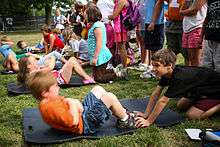
Urban calisthenics is a form of street workout; calisthenics groups perform exercise routines in urban areas. Individuals and groups train to perform advanced calisthenics skills such as muscle-ups, levers, and various freestyle moves such as spins and flips.
Sports teams and military units often perform leader-directed group calisthenics as a form of synchronized physical training (often including a customized "call and response" routine) to increase group cohesion and discipline. Calisthenics is also popular as a component of physical education in primary and secondary schools over much of the globe.
In addition to general fitness, calisthenic exercises are often used as baseline physical evaluations for military organizations around the world. Two examples are the U.S. Army Physical Fitness Test and the U.S.M.C. Physical Fitness Test.
History
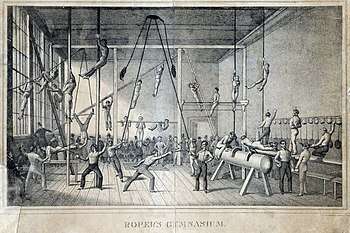
The word calisthenics comes from the ancient Greek words kalós (καλός), which means "beautiful" (to emphasize the aesthetic pleasure that derives from the perfection of the human body), and sthenos (σθένος), meaning "strength" (great mental strength, courage, strength, and determination). It is the art of using one's body weight as resistance in order to develop physique. The practice was recorded in use in Ancient Greece, including the armies of Alexander the Great and the Spartans at the Battle of Thermopylae.[1]
Catharine Esther Beecher (1800-1878), was an American educator and author who popularized and shaped a conservative ideological movement to both elevate and entrench women’s place in the domestic sphere of American culture. She introduced calisthenics in a course of physical education and promoted it.
Disciples of Friedrich Ludwig Jahn brought their version of gymnastics to the United States, while Catharine Beecher and Dio Lewis set up physical education programs for women in the 19th century.[2] Organized systems of calisthenics in America took a back seat to competitive sports after the Battle of the Systems, when the states mandated physical education systems.[3] The Royal Canadian Air Force's calisthenics program published in the 1960s helped to launch modern fitness culture.[4][5]
Calisthenics is associated with the rapidly growing international sport called street workout. The street workout consists of athletes performing calisthenics routines in timed sessions in front of a panel of judges. The World Street Workout & Calisthenics Federation (WSWCF) based in Riga, Latvia orchestrates the annual National Championships and hosts the World Championships for all the national champions to compete at one competition. The World Calisthenics Organization (WCO) based in Los Angeles, CA. promotes a series of competitions known globally as the Battle of the Bars. The WCO created the first-ever set of rules for formal competitions, including weight classes, timed round system, original judging criteria and a 10-point must system - giving an increasing number of athletes worldwide an opportunity to compete in these global competitions.
Common exercises
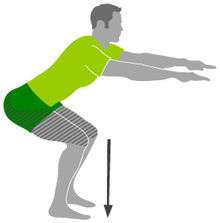
The more commonly performed calisthenic exercises include:
Most common
- Performed face down on the floor, palms against floor under the shoulders, toes curled upwards against the floor. The arms are used to lift the body while maintaining a straight line from head to heel. The arms go from fully extended in the high position to nearly fully flexed in the low position while avoiding resting on the floor. Chest, shoulders, and triceps are trained with this exercise. An easier version of this exercise consists of placing the hands on a wall and then bending and straightening the arms.
- A person lies on their back with their legs bent. They bend at the waist and move their head and torso towards their legs. They then lower themselves back down to the start position. For people who find it difficult to get down onto the ground, a similar range of motion can be achieved by standing with the legs slightly bent, and then bowing slightly and straightening up again.
- Standing with feet shoulder-width apart, the subject squats down until their thighs are parallel with the floor; during this action, they move their arms forwards in front of them. They then return to a standing position whilst moving their arms back to their sides. Squats train the quadriceps, hamstrings, calves, gluteal muscles, and core. The height of the squat can be adjusted to be deeper or shallower depending on the fitness level of the individual i.e. if someone struggles with exercise they can do half or quarter squats. They are among the most versatile calisthenic exercises because they can be performed easily in most environments and with a limited amount of space.
Common
- A full body calisthenics workout that works abdominal muscles, chest, arms, legs, and some parts of the back.
- Chin-ups and pull-ups
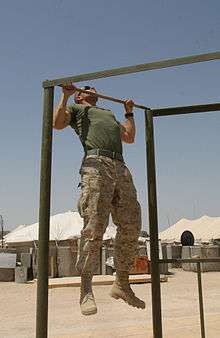
- Chin-ups and pull-ups are similar exercises but use opposite facing grips.
- For a chin-up, the palms of the hands are facing the person as they pull up their body using the chin-up bar. The chin-up focuses on the biceps muscles, rather than the latissimus dorsi muscle which is the focus of the pull-up.[6]
- For a pull-up, the bar is grasped using a shoulder-width grip. The subject lifts their body up, chin level with the bar, and keeping the back straight throughout. The bar remains in front of the subject at all times. The subject then slowly returns to starting position in a slow controlled manner. This primarily trains the lats or upper back muscles, as well as the forearms.
- Done between parallel bars or facing either direction of trapezoid bars found in some gyms. Feet are crossed with either foot in front and the body is lowered until the elbows are in line with the shoulders. The subject then pushes up until the arms are fully extended, but without locking the elbows. Dips focus primarily on the chest, triceps, and deltoids, especially the anterior portion.
- A front lever is performed by performing a lat pulldown of the bar with straight arms until the body is parallel to the ground, with the front of the body facing upwards. May be done on rings or pull-up bar.
- A back lever is performed by lowering from an inverted hang from rings or bar, until the gymnast's body is parallel to the ground and facing towards the floor.
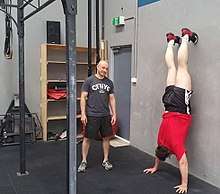
- A handstand is the act of supporting the body in a stable, inverted vertical position by balancing on the hands. In a basic handstand, the body is held straight with arms and legs fully extended, with hands spaced approximately shoulder-width apart.
- Performed in a prone position on the ground, the individual raises the legs, arms and upper body off the ground.
- Lying on the back, hands in fists under buttocks, move feet up and down.
- The L-sit is an acrobatic body position in which all body weight rests on the hands, with the torso held in a slightly forward-leaning orientation, with legs held horizontally so that each leg forms a nominal right-angle with the torso. The right-angle causes the body to have a notable "L" shape, hence the name "L-sit". The L sit requires you to keep your core tensed and hold your legs horizontal so your body sits in a perfect 'L' position. This requires significant abdominal strength and a high level of hamstring flexibility.
- One of the basic calisthenics routines. Performed by a combination routine of a pull-up followed by a dip. May be done on pullup bars or rings.
- This is the name for holding the 'top' position of a push-up for extended periods of time. The primary muscle involved in this exercise is the rectus abdominis.
- This is running back and forth between two points (or cones) typically separated by 5-40 meters, as fast as possible, with a touchdown. The emphasis should be on stopping, turning back and accelerate back to a sprint as quickly as possible.
- Squat jumps
- A variant of the squat. Performed by entering a squatting position, then using a plyometric jumping movement to jump as high as possible.
Co-operative calisthenics
Co-operative calisthenics refers to calisthenic exercises that involve two or more participants helping each other to perform the exercise. Such exercises are also known as partner exercises or bodyweight exercises with a partner. Usually, one person performs the exercise and the other person adds resistance. For example, a person performing squats with someone on their back. Some exercises also involve the use of equipment. Two people may hold onto different ends of a rope and pull in different directions. One person would deliberately provide a lesser amount of resistance, which adds resistance to the exercise whilst also allowing the other person to move through a full range of motion as their superior level of force application pulls the rope along. A disadvantage such exercises have is that it can be hard to measure how much resistance is being added by the partner when considered in comparison to free weights or machines. The advantage they have is that they allow for relatively high levels of resistance to be added with equipment being optional. On this basis, co-operative calisthenics can be just as easily performed on a playing field as in a gym.[7] They are also versatile enough to allow them to be used for training goals other than simply strength. For example, a squat with a partner can be turned into a power-focused exercise by jumping or hopping with the partner instead, or even lifting them up on one knee.
Calisthenics parks

An increasing number of outdoor fitness training areas and outdoor gyms are being built around the world. Some are designed especially for calisthenics training and most are free to use by the public. Calisthenics parks have equipment like pull-up bars, monkey bars, parallel bars, and box jumps at one location. Freely accessible online maps exist that show the location and sample photos of calisthenics parks around the world.[8]
See also
References
- "How ancient Greeks trained for war". BBC. 2019-04-02. ISSN 0458-3035. Archived from the original on 2019-04-04. Retrieved 30 August 2019.
- "calisthenics (exercise)". Britannica Online Encyclopedia. Retrieved 2010-08-04.
- Higgins, Chris (2020-01-03). "Calisthenics History- How Calisthenics Once Ruled the Schools and Lost the Battle to Sports". Calisthenics Gear. Retrieved 2020-01-03.
- KRUCOFF, CAROL (1998-06-22). "Going Back to the Basics With Calisthenics". Los Angeles Times. ISSN 0458-3035. Retrieved 2018-10-08.
In fact, the popularity of the Royal Canadian Air Force's calisthenics program in the late 1950s helped launch the modern fitness movement.
- "Five basic exercises for fitness in 1961". CBC Archives. Retrieved 2018-10-08.
The program became famous worldwide.
- "Chin-Up Exercise Guide and Video". Bodybuilding.com.
- Kraemer, W.J. & Fleck S.J., 'Partner exercises' in Strength Training for Young Athletes, Leeds: Human Kinetics, pp.83-86
- "Calisthenics Parks - Spots Map". calisthenics-parks.com. Retrieved 2016-12-30.